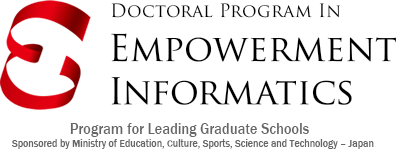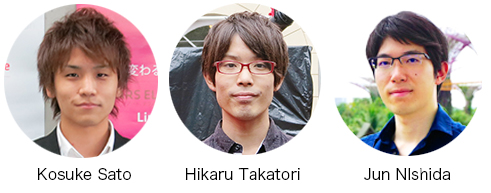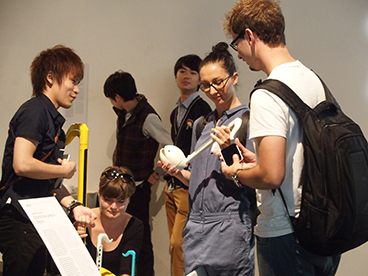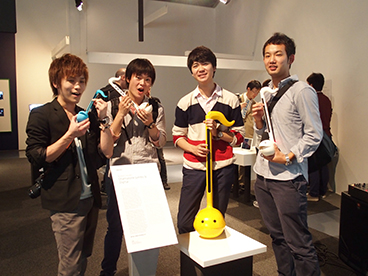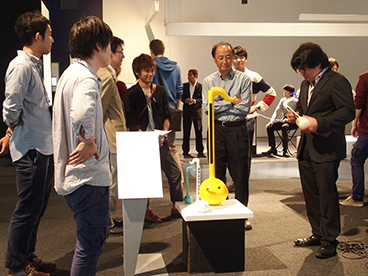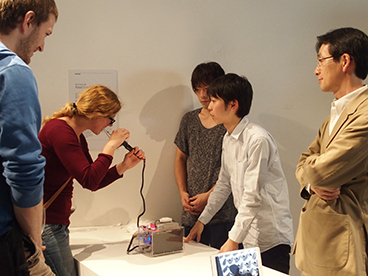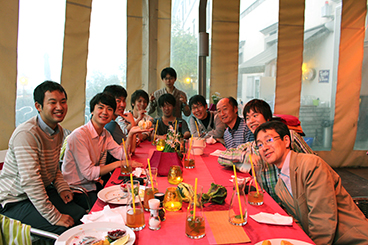Special feature: Student interview on the Ars Electronica 2014 international device art exposition
Taking part in management of the Ars Electronica 2014 international device art exposition
Q: What kinds of activities have you taken part in since the interviews at the event?
Sato: I have worked on activities including preparation of the venue for GALA 2014 (September 5), the awards ceremony for Prix Ars Electronica, guiding artists, and assisting in presenting the Golden Nica prize trophies. I also worked on preparing the venue for the Prix Forum session of discussions among winners in each category (September 6-7), guiding artists, providing information to attendees, and even operation.
Takatori: Today I assisted Hakuhodo staff and innovators in the group for which I was responsible as a communicator at the Future Innovators Summit. My specific activities included guiding them around the venue, preparing the working environments that innovators desired, and taking notes on the content of discussions. I also explained to attendees the principles behind exhibits inside the FIS venue and instructed them on how to experience the demonstrations.
Nishida: Prior to the field interviews I worked on setting up the “Robot Mask” exhibit, and since the interviews my activities have included demonstration preparation and practice for press conferences and checking the content of descriptions for release to the general public. I also have learned about knowledge related to my own research as well as knowledge on media arts through interaction with the artists who worked on other exhibited works.
Q: What kinds of things did you learn through this trip?
Sato: I was able to gain experience in organizing an event by taking part in the Ars Electronica Festival, a global media arts event that serves as a festival of arts, advanced technology, and culture, mainly through helping out behind the scenes. In addition, through organizing the Device Art exhibition I was able to learn about subjects such as methods of organization, including how to exhibit works to make them more attractive. Furthermore, through the Prix Forum I was able to witness the motivation of artists in preparing their works.
Takatori: The first thing I felt keenly was the need for English-language skills. I sensed this particularly while listening to discussions among innovators. I got a true feel for the fact that it would not be possible to achieve cooperation and partnership with others unless I improve my English abilities to the level where I can ask others’ opinions and discuss things with them in addition to of course being able to talk about my own current activities.
The next thing I sensed was the fact that in an event open to the general public the impression of the experience is more important than the principles or scientific meaning. The experience of attendees is an important focus from the preparatory stages of an exhibition. From Ars Electronica’s uncompromising attention to detail as seen for example in the way power cables are covered by colorful tape and the platforms for works are of solid color with no joints, I was able to see the kind of efforts to make to improve the experience of attendees.
Nishida: We were able to learn about various methods of expression such as how to use various engineering methods to create works that attempt to express the essence of their content, expressing engineering structures themselves as works of art, and designing interactions between people and giving them an artistic aspect. These will impact the ways we make things in the future. I also was reminded anew of the importance of visual design when I saw how exhibit panels and introductory videos employed effective visual communication design and visual effects.
Q: How would you like to put to use what you have learned at EMP and in your own activities?
Sato: I think I learned a lot about making works attractive in particular. In the future I plan to experience the research style of refining systems through exhibition at the Empowerment Studio. I would like to create such exhibits using what I have learned on subjects such as what kind of style of exhibit to create and how to publicize and promote it to get more people to come.
Takatori: Together with improving my own English-language abilities, I also sensed the importance of enhancing the content of my research. Even if I could speak English well, it would be pointless if I were unable to discuss my own current research in ways that make it sound attractive. For this reason, I would like to prepare to be able to explain proactively in English the content of presentations at academic conferences and other events, and then review it and take similar steps. Also, when presenting or exhibiting the content of my own research, I would like to be able to choose and modify content to make it attractive to the audience, in accordance with their own degrees of specialization.
Nishida: The event included activities such as workshops for attendees and the general public led by artists who took content with them to the exhibition venue and the Fablab (an open space usable by the public and others, equipped with a diverse range of machine tools). I felt that providing such opportunities for interacting with groups of people in a place suited to sharing and propagating knowledge would be very effective in the Program’s independent activities among students and the community. In particular, I felt that practical and conceptual lectures to the general public and students on each of the University’s pillars of supplementation, harmony, and extension would contribute to strengthening the Program’s presence.
Q: Lastly, what do you think is meant by presentation ability?
Sato: I feel that simply creating a work or a device does not mean that people will come to see it or that it will be well received. This internship showed me the need to communicate in understandable ways the subject you want to convey, in the essential parts. I think that presentation ability refers to methods of exhibiting works and devices that make people want to try them out and expression that reflects consideration for the people viewing and evaluating it.
Takatori: I think that it refers to what I mentioned earlier about the ability to choose and modify content so that it would appear attractive to each individual, in accordance with his or her own degree of specialization. I think that a stronger way of presentation employs the ability to identify the information that the viewer needs and make it visible in appropriate ways, through diagrams, video, or other means, instead of simply pushing on the viewer the information that you want to convey. Alternatively, it would employ the ability to provide the information that you want to convey in a form that is easier for the other party to accept, by describing it in a way that will arouse his or her interest (i.e., make the other party feel it is information they need).
Nishida: Through observing the activities of various artists at the event, I felt anew that presentation ability refers to not just to superior visual effects or storytelling but also to something like the persuasive ability to summarize the content and essence of the subject in their entirety and attract listeners. Artists propose new works to society on a daily basis, acting with the intention of identifying problems or providing creative stimuli. Students at a leading graduate school have many opportunities not only to provide simple descriptions but also to propose their own ideas to people, and from now on it will be important for them to acquire powers of persuasion, like artists. I felt that participating in an event like this exhibition in which artists who have carious methods of expression gathered together and experiencing and practicing state-of-the-art presentation ability will contribute greatly to fostering the presentation ability that the Program aims for.


